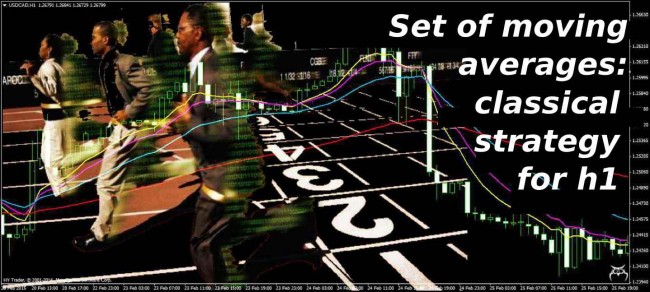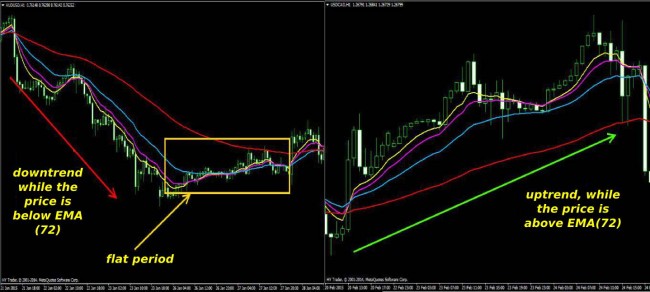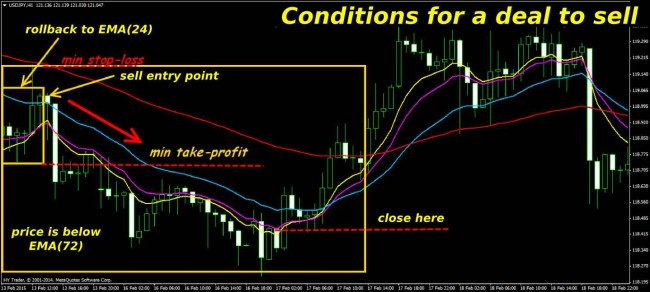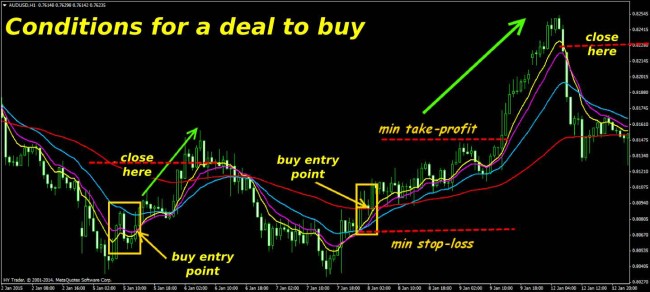The proposed strategy for h1 employs the classical method of working out the trend on the various periods. The optimal set of exponential moving averages allows to successfully filter the market without the use of oscillators. It is recommended for beginners and amateurs of the technical analysis.
Moving averages have always been considered a leading indicator of sentiment of the majority of market players. If the current price moves above the moving, it means that the market exceeds the expectations of investors, if below – it disappoints them. The fact of the average breakthrough always warns about changing trends.
Using averages makes it possible to trade in the direction of the strongest trends. The traditional delay of the moving averages in this strategy for h1 is removed using multiple averages with different periods – the faster ones act as filters for slower ones.
The principle of strategy operation and basic requirements
When calculating the exponential moving average, each value in the calculation is assigned a certain “weight”, and the “fresher” prices are less important, while more recent ones are considered more important for future decision-making. Thanks to this, EMA reacts faster to changes in price.
A more sensitive EMA indicator (with a smaller period) gives more false signals, while a less sensitive (greater period) – delays harder. The proposed combination allows to track the main trend, day trend and dynamics within the day. Quick averages act as dynamic support and stop levels.
Important: trade is conducted strictly according to the trend and on rollbacks in the direction of the main movement.
To secure the entry, mutual arrangement of the averages (from fast to slow) must match the direction of the trend. Strategy for h1 implies long- and medium-term positions, which requires a sufficient deposit and preferably small swaps, while dictating strict rules for managing capital.
System parameters and indicators setting
Only standard exponential moving averages are set on the H1 price chart, color-coded:
- EMA (8) – yellow;
- EMA (12) – purple;
- EMA (24) – blue;
- EMA (72) – red.
Trading with medium-volatile pairs with a stable trend is recommended: EUR/USD, GBP/USD, AUD/USD, USD/CAD, USD/CHF.
Timeframe to search for an entry point is M30, to trade – H1. The optimal time to enter is European/US session, do not enter half an hour before and after the news release, and then necessarily control the transactions in periods of possible non-standard volatility. Trading without stops is not recommended. "Lifetime" of the open transaction is from 1 day to several weeks.
Application of the strategy for h1 in trading
We believe that in this set of indicators:
- EMA(72) shows the main direction, or a three-day trend (24x3);
- EMA(24) keeps track of the general daily dynamics, filtering the market noise within the day, and is considered basic in the evaluation of the breakthrough strength before a possible rollback and change in trend;
- EMA(8) reflects the dynamics of trading volumes (or funds "turnover"), it most often serves as intraday support at a strong trend;
- additional EMA(12) is recommended for setup of dynamic stops.
While moving averages EMA(8), EMA(12) and EMA(24) are moving above EMA(72), the trend is considered "bullish" and we only open the deals to buy. We have similar rules for a downtrend.
Strategy for h1 can be used to open with the trend or on rollbacks. When the price goes against the trend into the area of EMA(12) and EMA(24) movings, it is a good opportunity to enter on a rollback.
The first entry method (conservative):
- EMA(8), EMA(12) and EMA(24) are located above (to buy) or below (to sell) the main EMA(72);
- the price rolls back to an average EMA(12) or EMA(24).
We open trade in the direction of the main trend with a minimum profit of 20-40 points and then hold to the discretion of the trader.
Important: the stronger the main trend, the smaller the rollback will be.
The second entry method (progressive):
Search for the entry point is conducted on M30 period. Key points:
- the price should break through the EMA(72) (the candle closed above – to buy, below – to sell);
- all movings with periods of 8, 12, 24 should be turned in the direction of the main trend and mutually arranged according to the direction of a possible transaction, i.e. EMA(8-12-24): in a downtrend upwards, in an uptrend – downwards).
Important: according to the strategy for h1, it is recommended to wait for another M30 candle to eliminate the "false" breakthrough before such an entry.
Trades are opened with a minimum profit (20-40) and then are held, depending on the overall trend.
The third method of entry (risky – for the lazy)
It is possible to trade with pending orders using this strategy for h1. At intersection and a complete reversal of EMA(8), EMA(12) and EMA(24) movings in close proximity (above/below) the main trend line, you can place a pending order BuyStop/SellStop behind the line of EMA(72), so that not to miss the moment of the breakthrough.
Reliability of such a signal requires sustained price movement behind the line of the fastest average EMA(8) after the point of intersection of the three movings. Then we monitor the open position in the usual manner.
Important: for any method of entry – if the potential size of the expected profit is less than 20 points, such trading signal should be ignored.
The most conservative stop-loss is placed behind the line of EMA(72), more loyal – behind the EMA(24). Since no additional indicators are used, the take-profits are usually placed according to the terms of money management. Trading-stop of the open position allows to pull the long trend to a maximum, and for the most reasonable exit of the transaction you can use the moment of crossing the EMA(12) line by EMA(24) in the opposite direction.
And as a conclusion...
The use of this strategy for h1 doesn’t give ultra-high profits, while allowing to catch all the big moves. It only works out the global trend and cuts intraday movements, and its stability is overshadowed only by a large number of "false" signals that appear at the end of the trend and at the transition to the flat movement.
In spite of this, the approach is popular due to its simplicity, use of the standard indicators and low risk. Practical application of the strategy over 2014 gave 727 profitable trades and only 59 unprofitable. If you carefully follow the instructions and aren’t greedy, you can get 2-3 reliable signals a day on medium-volatile tools, which is useful for beginners and can be an additional strategy for lovers of intraday trading. Source: Dewinforex
Social button for Joomla









